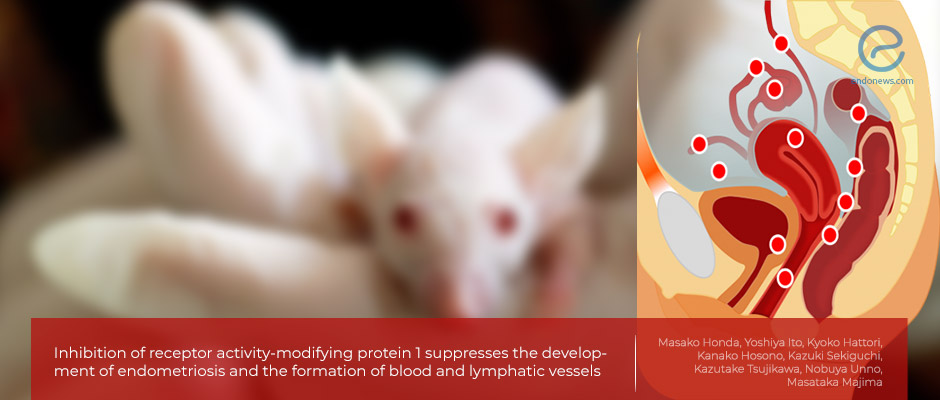New Signaling Pathway Could Be Crucial in the Development of Endometriosis
Nov 13, 2020
Signaling pathway for angiogenesis and neurogenesis in the development of endometriosis in a mouse model.
Key Points
Highlights:
- RAMP1 signaling is essential for the formation of blood and lymphatic vessels and the growth of endometrial tissue.
Importance:
- Blocking RAMP1 with antibodies or small molecule inhibitors could be a new therapeutic avenue for endometriosis.
What's done here:
- Researchers induced endometriosis in normal mice and transgenic mice lacking RAMP1 protein and investigated the formation of blood and lymphatic vessels as well as the growth of endometrial tissue in the peritoneal wall.
Key results:
- Endometrial tissue growth and blood and lymphatic vessel formation are suppressed in the absence of RAMP1
- Macrophages and fibroblasts are recruited to the implant site, and are the source of RAMP1.
- Implants are innervated with CGRP fibers.
- Inhibition of the CGRP receptors suppresses the growth of implants and the formation of new blood and lymphatic vessels.
Limitations:
The experiments were conducted in a mouse model and more research is needed before these findings can be translated into the clinic.
Lay Summary
RAMP1 signaling is crucial for growth and blood and lymphatic vessel formation in endometrial tissue, according to a new study published in the Journal of Cellular and Molecular Medicine. This suggests that blocking RAMP1 could be a new way to treat the disease.
Using a mouse model of endometriosis, researchers in Japan demonstrated that the neuropeptide calcitonin gene-related peptide (CGRP) and its receptor, Receptor Activity-Modifying Protein 1 (RAMP 1) are crucial for the growth of endometrial tissue.
Neuropeptides are small proteins produced by nerve cells that are responsible for the transmission of nerve signals. Also, the interaction between the nervous and immune systems is known to be involved in the development of endometriosis.
In order to examine the role of CGRP and its receptor, RAMP1 in the growth of endometrial tissue, the team of researchers led by Dr. Masataka Majima first transplanted endometrial fragments from mice into the peritoneal wall (the layer of tissue lining the inside of the abdomen) of the recipient mice to induce endometriosis formation. They saw that the endometrial fragments grew with increased density of blood and lymphatic vessels in the recipient animals.
When they repeated the experiment with tissue obtained from genetically modified mice that did not have any RAMP1 protein into the peritoneal wall of normal mice, the researchers observed that implant growth was reduced. There was also a reduced amount of blood and lymphatic vessel formation. The same was true when the implanted tissue was obtained from normal mice and implanted into mice that lacked RAMP1. The results were most striking when both the donor and recipient mice lacked RAMP1.
The researchers concluded that the growth of transplanted endometrial fragments is accelerated via RAMP1 signaling from both the implant and the recipient.
Analyzing other molecular markers, the researchers demonstrated that macrophages or fibroblasts were the sources of RAMP1 in the implants. Macrophages are cells of the immune system and fibroblasts are cells that play a role in wound healing. Both types of cells are known to be crucial for the growth of endometriosis. Researchers also noticed that the implants were supplied with CGRP+ nerve fibers. This result led them to conclude that CGRP in the nervous system plays a role in the progression of endometriosis via the RAMP1 signaling pathway.
Finally, when the researches inhibited the CGRP receptors, they saw that the growth of the implants and the formation of new blood and lymphatic vessels were suppressed.
They concluded that RAMP1 signaling is crucial for the growth and of endometrial tissue and the formation of new blood and lymphatic tissues. “Blockade of RAMP1 is a potential tool for the treatment of endometriosis,” they wrote.
Research Source: https://pubmed.ncbi.nlm.nih.gov/32869443/
mouse model RAMP1 macrophage fibroblast angiogenesis neurogenesis nerve fibers blood vessels lymphatic

